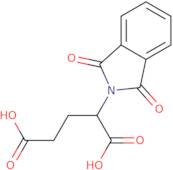Product Information
- Pht-DL-Glu-OH
- (1)-2-(1,3-Dihydro-1,3-dioxo-2H-isoindol-2-yl)glutaric acid
- 2-(1,3-Dihydro-1,3-dioxo-2H-isoindol-2-yl)pentanedioic acid
- 2-(1,3-Dioxo-2,3-dihydro-1H-isoindol-2-yl)pentanedioic acid
- 2-(1,3-Dioxoisoindol-2-yl)pentanedioic acid
- 2-(1,3-Dioxoisoindolin-2-yl)pentanedioic acid
- 2-Phthalimido-<span class="text-smallcaps">DL</span>-glutaric acid
- 2-Phthalimidoglutaric acid
- <span class="text-smallcaps">DL</span>-2-Phthalimidoglutaric acid
- Ba 2733
- See more synonyms
- Glutamic acid, phthalyl-
- Glutaric acid, 2-phthalimido-
- Glutaric acid, 2-phthalimido-, DL-
- N-Phthaloyl-L-glutamic acid
- N-Phthalyl-D,L-glutamic acid
- N-Phthalyl-DL-glutaminsaure
- N-Phthalyl-DL-glutaminsaure [German]
- N-Phthalyl-dl-glutamate
- N-Phthalylglutamic acid
- NSC 120849
- Nplg
- Nsc 43131
- Pentanedioic acid, 2-(1,3-dihydro-1,3-dioxo-2H-isoindol-2-yl)-
- Pentanedioic acid, 2-(1,3-dihydro-1,3-dioxo-2H-isoindol-2-yl)-, (S)- (9CI)
- Phthaloyl-dl-glutamic acid
- Phthalylglutamic acid
- 2-(1,3-Dihydro-1,3-dioxo-2H-isoindol-2-yl)glutaric acid
Phthaloyl-DL-glutamic acid (PDG) is a basic fibroblast growth factor that promotes the proliferation of muscle cells. PDG has been shown to induce the generation of reactive oxygen species and to produce oxidative stress, leading to DNA damage. PDG also binds to the dopamine D2 receptor and increases the uptake of dopamine in cells, which may be responsible for its ability to inhibit fibrinogen production by binding with fibrinogen receptors in the occipital cortex. PDG is present in lacrimal glands and binds with high affinity to CD1a receptors on mouse T-cells.





